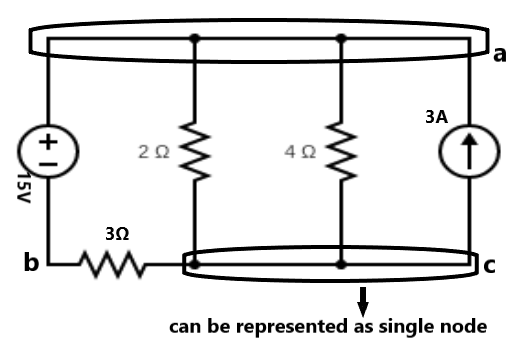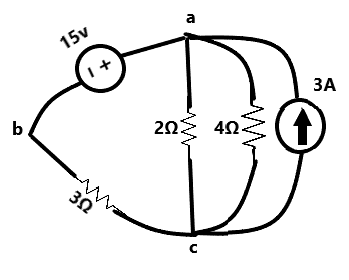Node, Branch, Loop, and Elements in series and parallel
In representation or analysis of an electrical network we use or define many terms. Such terms include branch, node, loop, etc. Let us discuss each of them one by one
Branch
A branch represents a single element. In other words, a branch represents the two-terminal element in an electrical circuit. For example: In the figure, there is a total of five branches namely, the 15V voltage source, the 3Ω resistance, the 2Ω resistance, the 4Ω resistance, and the 3A current source.
Node
A node is a point of connection between two or more branches. It is usually denoted by a dot in a circuit.
Note: If a short circuit (perfectly conducting wires) connects two nodes, the two nodes constitute a single node. For example, In the given figure the three points that form node c are connected by perfectly conducting wires. Similarly for node a.


Loop
A loop is a closed path formed by starting at a node, passing through a set of nodes without passing through any node more than once.
Independent loop
A loop is said to be independent if it contains at least one branch which is not a part of any other independent loop. There can be more than one set of independent loops in a circuit. In the given figure one set of the independent loops is bcab with 2Ω resistance, bcab with 4Ω resistance, and bcab with 3A current source.
Note: Independent loops or paths result in an independent set of equations. (Useful at the time of solving circuit.)
Fundamental theorem of network topology
An electrical circuit with b branches, n nodes, and l independent loops will satisfy the fundamental theorem of network topology.
b=l+n-1
In the above circuit diagram, there are five branches (b=5) and three nodes(n=3). So the number of independent loops is
b=l+n-1
⇒l=b-n+1=5-3+1=3 independent loops
Electrical elements in series and parallel
Two or more elements are in series if they exclusively share a single node and consequently carry the same current.
Two or more elements are in parallel if they are connected to the same two nodes and consequently have the same voltage across them.